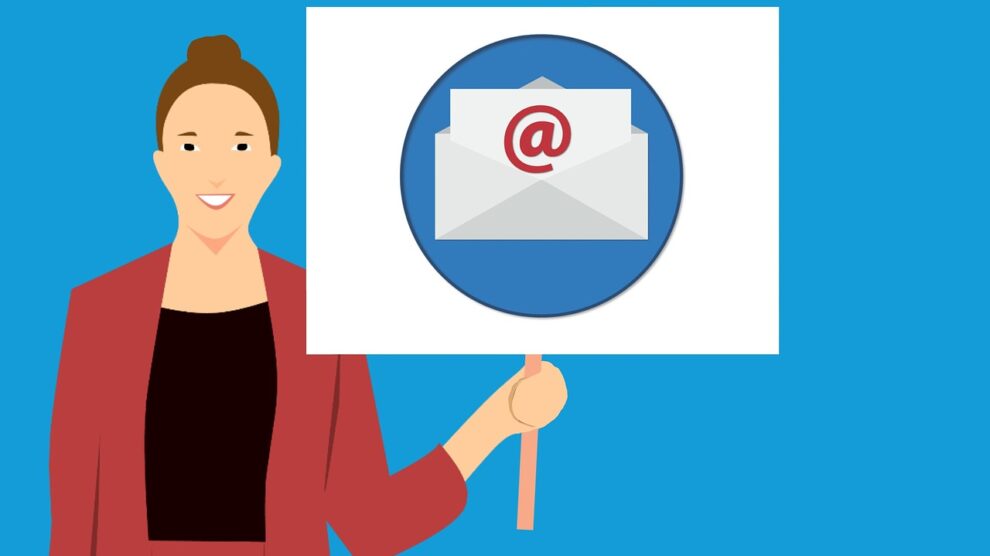The email marketing industry may be nearly four decades old, but it has had an enormous impact on helping businesses generate leads. In the marketing world, the global pandemic has shaken things up but, it’s critical to pay attention to trends as a digital marketer so you can remain on top of evolving best practices without disrupting your overall marketing strategy.
Since 2017, the number of e-mails sent and received globally has increased each year as the internet has become more accessible. While over 306.4 billion e-mails were sent and received per day in 2020, this number is predicted to rise to over 376.4 billion per day by 2025. With emails set to remain a significant part of daily business life, prudent companies should aim to use a variety of email marketing strategies. This can be done to enhance revenue, boost brand reputation, and gain a competitive advantage. Despite the fact that social media and mobile marketing are becoming increasingly popular, email continues to be one of the most effectual ways for brands to retain customers and acquire new ones.
We have created a list of email marketing predictions for 2021. With these predictions, you will have the tools you need to keep your brand ahead of the curve and your competitors in 2021. It may be argued that the impact is much more significant now to tackle the COVID-19 pandemic’s marketing challenges and obstacles. As we shift to the ever-changing marketing landscape brought about by COVID-19, brands have made the shift to digital marketing channels.
“According to a HubSpot analysis, email marketers are sending 27% more emails than they then did pre-coronavirus.”
Email Marketing Predictions for 2021!
1. More Personalized Messaging Across All Channels
Marketers already know that personalized emails get better open and transaction rates. Personalization has always been key to successful engagement.
“According to a report by Oberlo, personalized subject lines can generate approximately 50 percent increase in open rates over standard subject lines.”
Personalizing content based on subscriber behavior is becoming increasingly crucial for email marketing brands because it increases engagement rates by sending more relevant messages. However, this trend is likely to go further in 2021, but it will be driven by AI technology, making personalization even more sophisticated than ever before.
If you have ever used email marketing, you know how important personalization is.
- According to Campaign Monitor, emails with individualized subject lines are 26 percent more likely to be opened.
- Experian also discovered that personalized emails result in a 6X increase in transaction rates.
In 2021, however, simply including your recipient’s name in your email subject line and email copy will not be enough to persuade most consumers. Consumers increasingly expect hyper-personalized content that provides them with relevant information and feels as though it was created just for them.
According to Lucid, around 20 percent of individuals will unsubscribe from a newsletter if the content or promotions do not match their preferences.
The procedure of grouping email subscribers into smaller segments depending on specific criteria is known as email list segmentation. This could include any information such as location, purchase history, interests, behavior, and more. Rather than broadcasting the same messages, email marketers may use these segments to develop personalized content for each segment.
“According to a report by Instapage, personalised messages have an ROI of 122 percent.”
This approach will be a lot easier if you utilize an email marketing solution that allows you to use dynamic content. Dynamic email content is any personalized component of a marketing email that changes depending on your email list segments. By segmenting your mailing list and adding variables to it, you can create hyper-personalized emails.
2. Integrating Artificial Intelligence into Email Marketing Strategies
Many organizations are still perplexed by the concept of AI (Artificial Intelligence). Many newcomers and seasoned marketers are skeptical of the usage of Artificial Intelligence as an effective email marketing approach. Despite current technology, marketers will find more data online than they could with cutting-edge tools. AI can acquire data with minimal effort. There is ample evidence that AI can outperform humans in terms of effective outreach, list segmentation, and content analysis, etc. Artificial Intelligence can also perform activities such as recognizing emotions, diagnosing illnesses, and resolving issues.
The capabilities of AI are more likely to expand and reach more significant boundaries with the current technologies. Because we live in a technological era, AI will soon accomplish most human tasks faster, better, and more precisely than humans. This means now is an excellent opportunity to learn about Artificial Intelligence and incorporate it into your email marketing strategies to effectively optimize your marketing campaigns.
3. Brands Will Encounter More Challenges Related to Privacy Laws
Privacy has never been more crucial than it is now, thanks to GDPR. Some email marketers are concerned that stringent privacy laws might reduce the effectiveness of their email marketing operations or that they will be unable to continue email marketing at all.
Anti-spam regulations have been in place for quite some time, and as a result, businesses have been forced to streamline their email marketing best practices. This has improved the email marketing experience for both marketers and consumers, rather than reducing the effectiveness of email marketing. In fact, 56 percent of marketers are pleased with the GDPR’s impact on their email marketing (UK DMA Email Marketer Tracker).
Listed below are the advantages of GDPR and improved privacy:
- Opt-out rates have decreased for 41 percent of email marketers.
- 76 percent of respondents stated their open rates have increased.
- There have been reduced spam complaints, according to 55 percent of respondents.
- 75 percent said their click-through rates have increased.
4. Interactive Emails
Improving customer engagement with interactive emails is a trend that all email marketers should follow in 2021. For interactive emails, AMP (Accelerated Mobile Pages) will be a game-changer. You can incorporate interactive content in your marketing emails using AMP. If you want to highlight a few different products, you can include a carousel and shopping options right in the email instead of connecting to a landing page.
This ensures that your subscribers will be able to shop, explore products, and more right from their inbox. There’s no need to click several times to reach the appropriate page only to make a transaction. When you lower friction and make it easy for subscribers or buyers to complete an action, you are boosting the chances that they will actually do so. You will notice that you can pick the color of your Google Pixel Buds right from the email and add it to your cart. Users will find it much easier to complete their purchases right away as a result of this.
Unfortunately, AMP is not supported by all email marketing service providers. To take advantage of this excellent marketing strategy, put pressure on your current provider or find a new one.
5. Omnichannel Marketing for Lead Nurturing
Nurturing leads isn’t limited to email. This is why Omnichannel marketing is crucial. Omnichannel marketing is the process of sending appropriate marketing messages to your customers across digital and traditional marketing channels, regardless of the marketing channels you employ to engage with them.
Omnichannel marketing is effective because it meets customers where they are. Shoppers aren’t going to go to a website and buy something. Before making a purchase, today’s shopper consults a number of different sources. Brands can engage with their potential customers across multiple marketing channels and platforms with omnichannel marketing. Brands can make sure that questions are answered, and requirements are met through this cross-channel engagement, eliminating barriers to purchase.
Omnichannel marketing includes:
- Organic search
- Organic social
- Social media ad re-marketing
- Programmatic ad re-marketing
- Online e-commerce marketplaces
- YouTube videos
- Podcasts
- Reviews and more
Omnichannel integration is also already well underway – for example, many brands now offer customers personalized experiences based on past interactions across different channels. However, this area is still developing and will continue to do so in the years ahead as marketers strive to provide more engaging customer experiences.
6. Text-Only Emails
Sending a text-only email to your customers can be a refreshing change of pace. To get the most out of your text-only emails, mix them in with your other designed and templated emails. Use your less flashy emails when you want to get a little personalized or are trying to engage with your subscribers on a deeper, more personal level to get the most out of them.
7. Email Marketing Automation
Email marketing automation alias drip campaigns are an effective email marketing strategy that use a series of trigger-based emails rather than one-time shots. This guarantees that subscribers and the firm are communicating consistently and cohesively. Additionally, it provides the customer with a sense of control over their inbox.
Drip email campaigns perform better than conventional email campaigns because of this. Specific actions done by users trigger the launch of the sequence. Emails sent as part of a drip campaign are more responsive and build a far more “friendly” relationship between the client and the firm.
When analytics and email marketing are integrated, hyper-personalized email marketing campaigns based on user behavior can be triggered. This process allows your subscribers to select what information they want to receive from you and how often they want to receive it or deliver personalized shopping recommendations based on their purchase history.
“According to a report by Epsilon, automated emails have a 119 percent higher click rate than broadcast emails.”
We recommend the following email marketing automation strategies:
Create a Welcome Email Series
A concise welcome email series is an excellent method to onboard new subscribers, establish expectations, and boost engagement.
Send Better Transactional Emails
Transactional emails are confirmation messages that you send to users after they have performed an action on your website. They can generate up to 6X more revenue and have up to 8X higher open rates than any other email (Campaign Monitor). They can help you sell, upsell, and drive engagement.
Send Anniversary or Birthday Emails
Emails on anniversaries and birthdays show your consumers that you care about them. You can boost your revenue by including a special deal.
“According to a report by Experian, birthday emails can generate 342 percent more income per email than a standard promotional email.”
Send Emails Based on Website Activity
Several email marketing automation systems may be integrated with your website to trigger email campaigns based on visitor actions.
These are just a few strategies to make your email marketing more automated. There are countless alternatives.
8. Increased Investment in Email Marketing
Marketers will be seeking less expensive marketing choices with a higher ROI as organizations continue to manage COVID-19 and determine what it means for their businesses. Email marketing has the highest ROI of all other marketing methods, at 4200 percent, or $42 for every $1 spent; therefore, it should come as no surprise that investment in email marketing will increase.
Email marketing, on the other hand, is a pretty broad marketing technique. Where should you invest your email marketing dollars?
Dynamic Segmentation
Dynamic segmentation is one of the most significant things you can do to improve engagement from your email marketing. We have already discussed personalization, so that we won’t go over it again, but segmenting your subscribers and then sending them content that they are interested in will yield the best results.
Re-engagement
Re-engagement campaigns are another excellent way to invest your email marketing dollars. Sending abandoned cart emails to motivate customers to finish their purchase, sending personalized product recommendations, sending exclusive promotions to inactive subscribers, and more are included in this.
Wrapping Up!
COVID-19 has wreaked havoc on businesses all across the world. However, it has allowed firms to experiment with new marketing strategies and even business models. We’ll see these new ideas put into action in 2021, with a focus on “people first.” Brands will become more empathetic, resulting in stronger customer-brand relationships. And email marketing is the ideal marketing channel for building partnerships. Brands will pay even more attention to customers’ voices and demands in 2021, reimagining their brands and business models to be more empathetic and human-centered. With the email marketing predictions for 2021 that we have provided, you’ll be prepared to face whatever the year brings.





